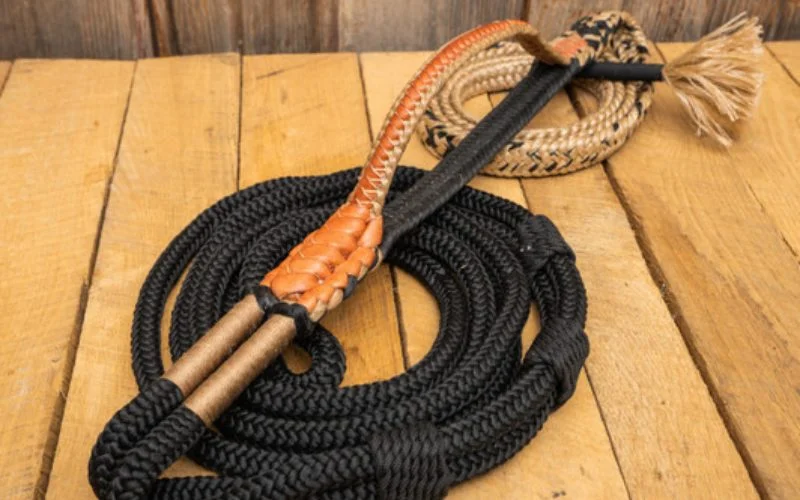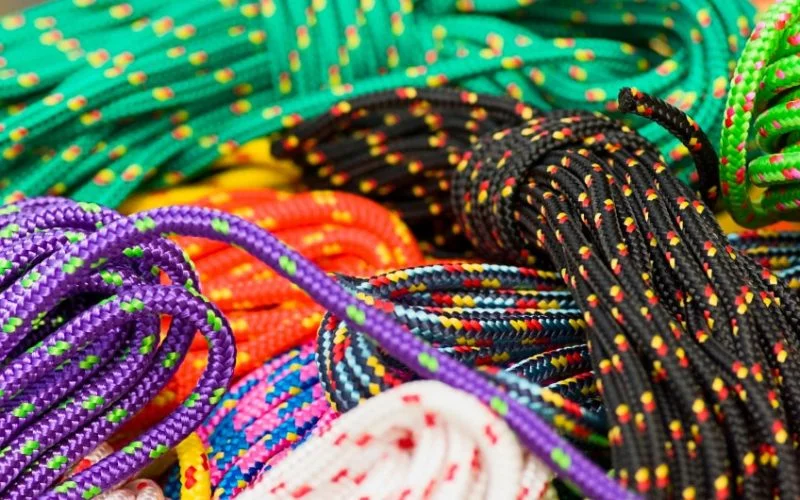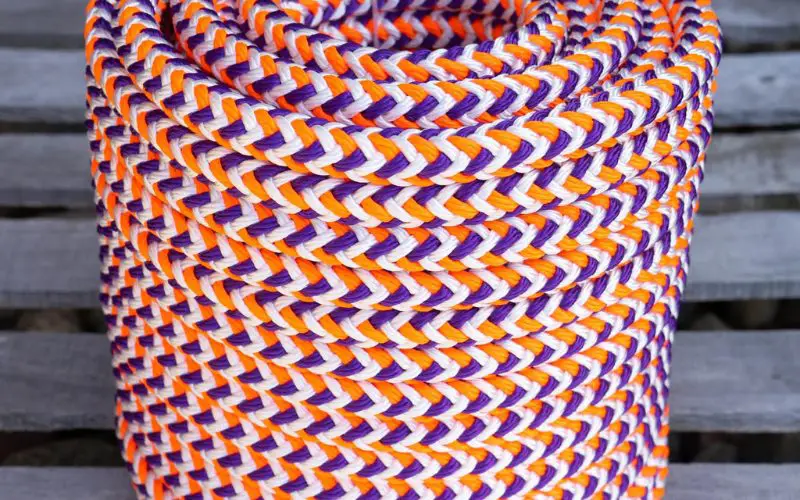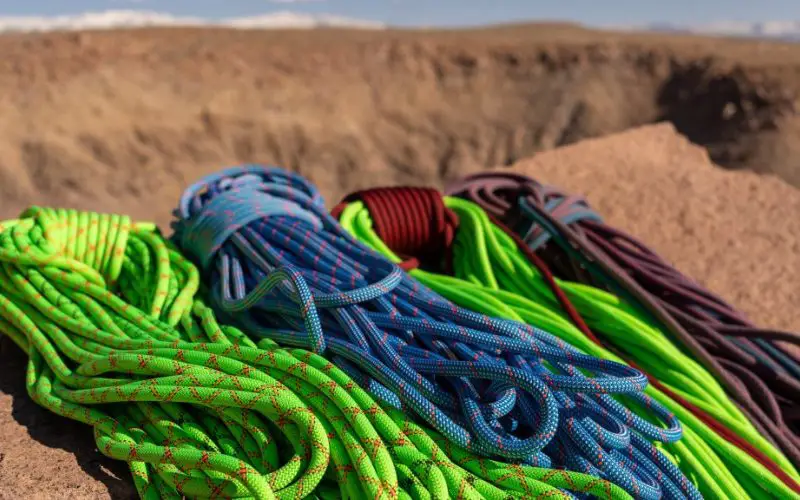Numerous types of rope are out there, and it can take time to know which one to use for what purpose. This blog post will look at two types of rope often used in rigging: bull rope vs. rigging rope.
We’ll compare and contrast the two, so you can decide which one is right for your needs and the features that make it the suitable option.
READ: Is Rope Or Chain Better For A Tree Swing?
What is a bull rope?

Bull rope, also known as bale cordage, is used for tying down loads. It’s much thinner than rigging rope and can hold tiny knots very well because of its high-strength polyester core wrapped in nylon fibers. It makes it great for securing small cargo on vehicles or even attaching small items to your belt while climbing. The bull rope comes in various diameters, the most common being 1/4 inch and 5/16 inch. Because the bull rope is so thin, it’s easy to weave through ropes or cables to tie off smaller loads.
The central feature of bull ropes is that it is a static rope, which means it is designed to extend only a small distance when force or load is applied to them. That makes them perfect for heavy-duty activities for climbing, rescue duties, and transporting heavy materials.
What is a rigging rope?

Rigging rope is used for the actual rigging of something. Because of its nylon outer sheath, it’s very durable and can withstand a lot of wear and tear. It makes it great for anchoring points or tying down cargo on vehicles. The diameter of a rigging rope varies depending on what you need it for. For example, if you need to pull a load over rough terrain, you’ll want to use a giant diameter rope like 3/4 inch or 1-1/4 inch. If you’re anchoring points and tying down cargo on vehicles, 5/8 inch will be more than sufficient.
Arborists usually use rigging ropes to work on trees, and theta is available either as a single or double braid. The single braid can be a hollow or solid type. The hollow type consists of fibers tightly braided to form an empty core, while a single solid braid has its core filled up. A double-braided rigging rope has a braided core and a braided jacket for additional durability.
Types of materials for rope construction
In previous sections, we explained that bull and rigging ropes could be made up of various materials simultaneously. Here are some adequate materials for constructing these ropes and their unique features.
Polyester
Polyester is a strong material with a tensile strength very close to nylon. Most durable ropes are made of this material, and this is because it has some features that make it ideal for several tasks.
- It has a high tensile strength
- It is breathable
- It does not stretch. Any minimal stretching should have been done after production
- It retains its strength even when wet
- It is resistant to UV rays as it is known to only lose 2% of its quality after being outside for two years
- It is resistant to abrasion
The tensile strength of any material is the level at which it can be stretched until it breaks, dramatically determining the load a material can hold. The load polyester is capable of holding should be just a fraction of its tensile strength. Polyester is used as the outer covering when paired with nylon because of its resistance to UV rays.
Nylon
Nylon is known to be made from synthetic polymers, and using this material for rope construction guarantees durability for carrying out heavy-duty tasks. Here are the features that make nylon one of the best materials for rope construction.
- It has a high tensile strength that surpasses that of polyester
- It is elastic and capable of returning to its original position after being stretched
- It is chemical and UV resistant. However, its resistance to UV rays is not as high as that of polyester
- Quality nylon material has a great shock absorption property
However, nylon does not retain strength when in water as it tends to soak it up and become weak. It is usually used as the inner material because of its durability, and a more UV-resistant and less elastic material is required to protect it as an outer covering.
Polypropylene
Polypropylene has many desirable qualities that make it great for rope construction. However, it could have better tensile strength, like nylon and polyester. Here are some of this material’s basic features that make it considered for rope construction.
- It floats on water and still retains its strength when wet
- It is resistant to UV rays
- It is resistant to abrasion
- It is light, which makes it best for outdoor domestic use
This material is usually paired with polyester, which stays on the inside, and polyester is used as the durable outer covering.
Bull rope vs. Rigging rope – which is best for climbing?

After learning about bull and rigging ropes, one thing is obvious: They are both durable and made with quality. So which one is the best fit for you? This section covers the differences between these ropes based on different features. This comparison should help you determine what you need.
Stretch
Rigging has a lot more stretch to them when compared to bull ropes, and this is because they are made of more nylon than polyester. That makes them suitable for climbing and hauling items that have a limited amount of weight. However, the non-elastic property of bull ropes makes them perfect for lifting heavy items.
Durability and knot strength
Both bull and rigging ropes are durable as they are made from high-quality materials. However, the more nylon a rope contains, the stronger it is. Rigging ropes are known to be made more of nylon than any other materials, so they can tolerate a high amount of [pressure and tension put on them. It makes them better than bull ropes in terms of durability.
Flexibility
Bull and rigging ropes have just the right amount of flexibility. However, rigging ropes are more flexible than bull ropes as they are made of more nylon. If the task you need to carry out requires your rope to have more flexibility, then you should choose rigging rope as your ideal match.
The inelastic property of bull rope makes t perfect for climbing trees, just like an arborist. That is because they are durable, and their flexibility is unnecessary in such a situation.
With all the comparisons, it is evident that rigging ropes are the better choice. However, this depends on the task you intend to carry out with these ropes. If you need something to support your weight or an object with an equivalent weight, then you need a bull rope as it is inelastic and not easily affected when wet.
Frequently asked questions
This section covers some questions concerning bull and rigging ropes and how their features apply to their usage.
Which rope is best for gym use and exercising?
Many people exercise with ropes for intense activities to grow their muscles and overall physical well-being. The kind of rope you need for exercising depends on the activity you intend to carry out. If you are engaging in exercises that require you to put most or all of your weight on the rope for a short time or if flexibility is a priority, then we recommend using a rigging rope.
Which rope is best for outdoor activities?
Outdoor activities that require pulling on heavy objects or supporting your weight for a long time call for using a bull rope. Bull ropes offer durability, which is needed, and inelasticity. When moving heavy objects or pulling, flexibility is not a priority and is not needed.
What kind of rope do arborists use?
Arborists use ropes to bring down the limbs of trees at different intervals to enable easy felling of trees. That calls for a rope that guarantees the safety and completion of work. The ideal rope can withstand harsh weather conditions and extreme pressure. It should also have a little stretch for absorbing kinetic energy when it might slip.
Durability is another factor they consider, hence why they prefer rigging rope to bull rope.
Conclusion
You may be going for outdoor activity, exercising, or looking for a rope for heavy-duty work, so you need to know which rope is best for you. We have described bull rope and rigging rope in a detailed manner that informs you about what you need to know about its appearance and features.
Helpful Articles:
- How to Hang a Tree Swing on an Angled Branch
- How to Hang a Swing from a Tree Without Branches
- 3 Easy Methods to Hang a Swing Between Two Trees
A brief comparison based on several factors is also included to provide more insights into what you need to know. The FAQs should conclude any other questions concerning these two types of ropes.
Kindly reach out to people by sharing this post on social media.
If you liked this article, then please follow us on Facebook, Instagram, and Pinterest.

